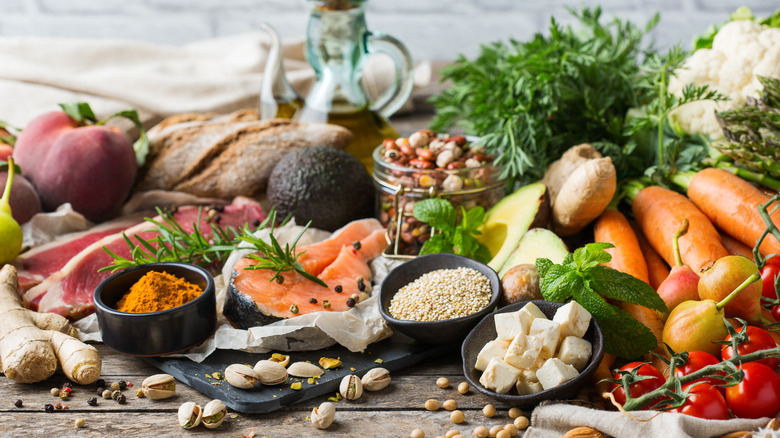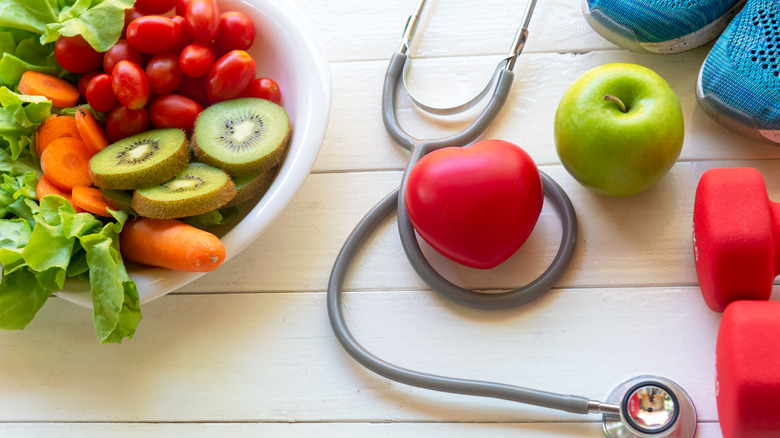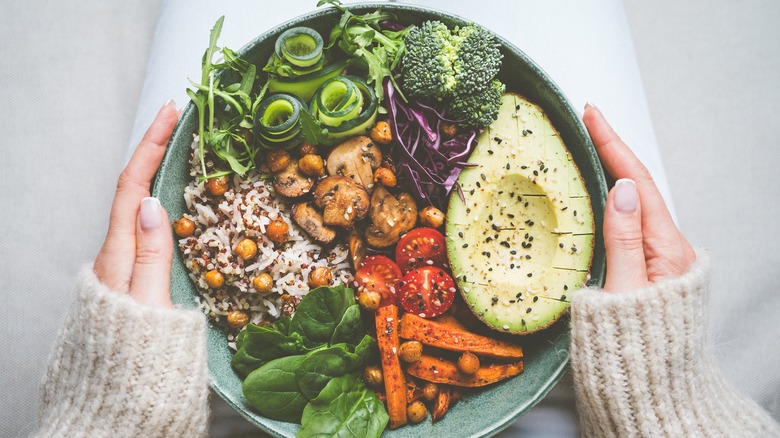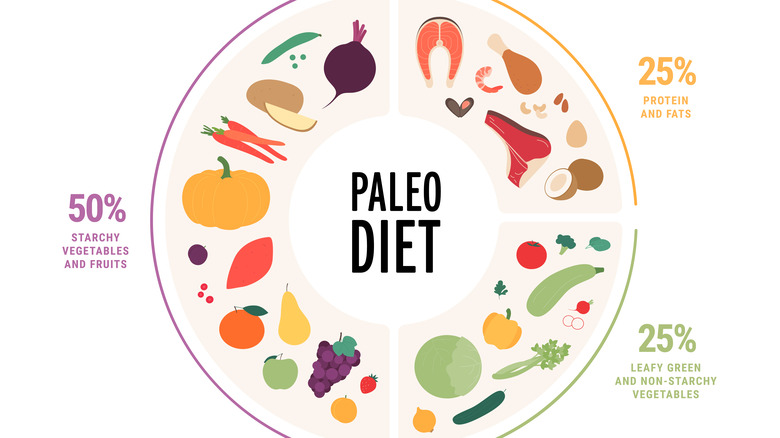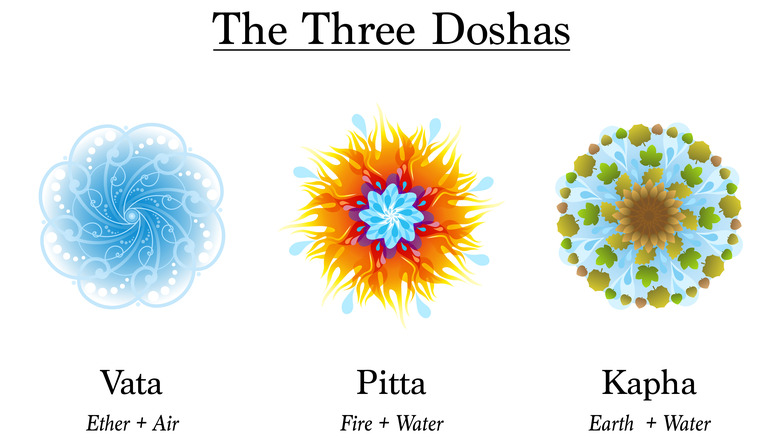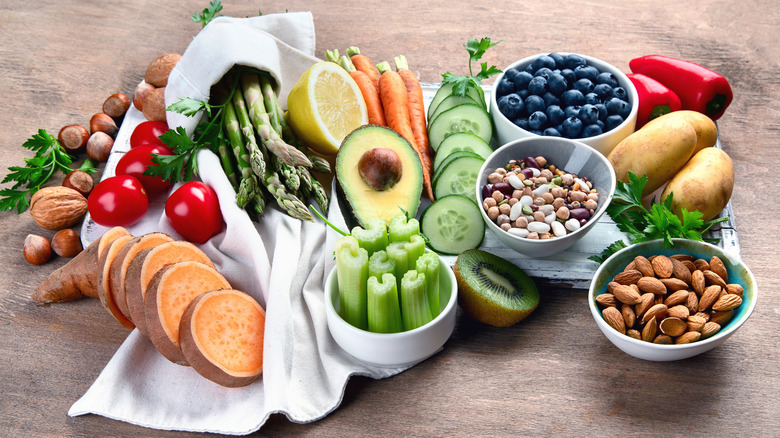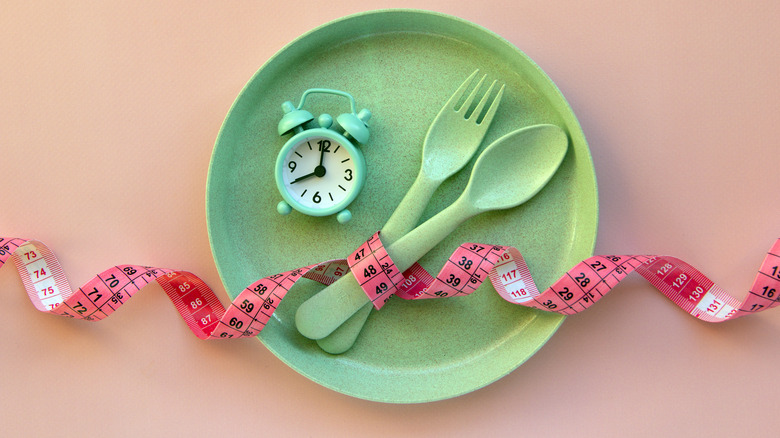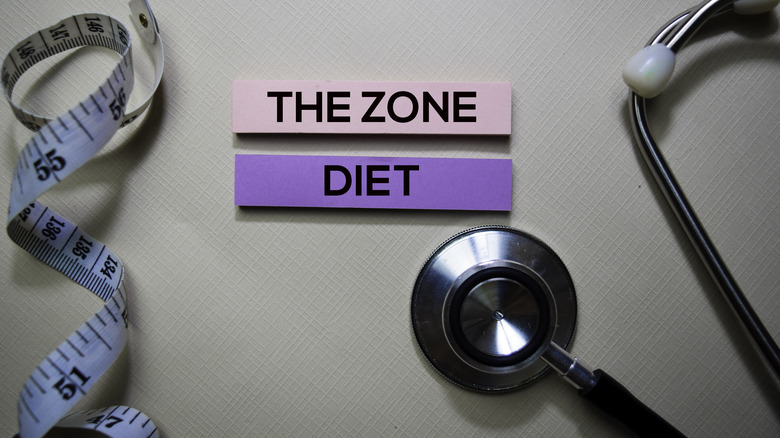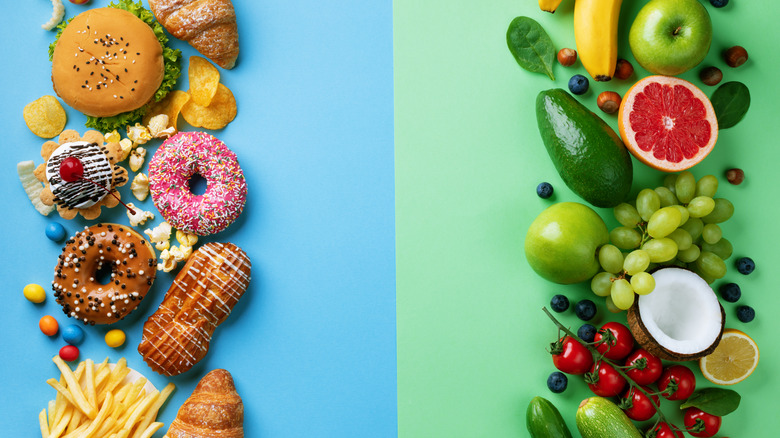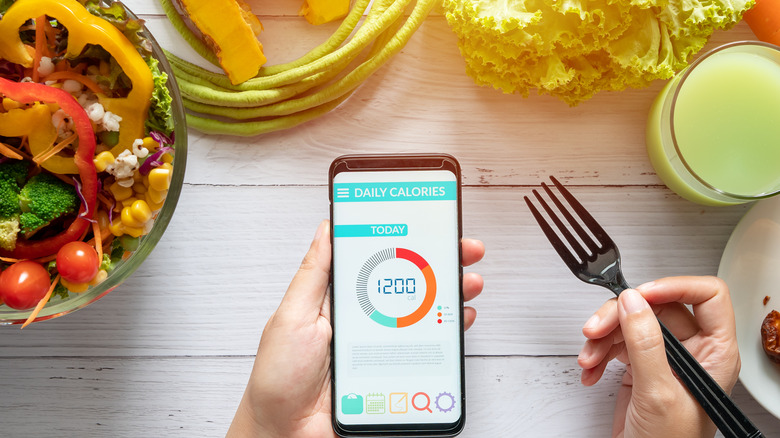What Actually Happens When You Stop Following Your Diet
Anyone who attempts a diet sure has a reason — it could be weight loss or weight management, a recent diagnosis, disease prevention, or adopting better habits. Searching for a diet to follow gives you several hits, each promising glorious results. Some diets have celebrities swearing by them, some have research backing them, and others become obsolete as quickly as they rose in popularity.
According to Boston Medical Center, about 45 million Americans start a diet each year, but staying on a diet can be challenging. You may get overwhelmed by cravings for prohibited foods, the new way of eating might be too alien, or perhaps the diet just doesn't work. Then you break your diet. Well, quitting diets is also pretty common. One U.K. survey by Alpro "... found that two out of five dieters quit within the first seven days. One out of five last a month, and the same number make it to the three-month mark, while the remainder stay dedicated for at least six months. However, only one in 20 is likely to still be following their new healthy eating regime after one year." (via Daily Mail). Are there consequences to breaking a diet? Here's what you could lose or gain if you stop following some diets.
The Mediterranean diet
The idea of the Mediterranean diet or MedDiet started with the Seven Countries Study in 1950. Researchers found that people in the Mediterranean region lived longer but didn't get diseases that came with longer life, such as cancer and coronary heart disease. The secret — their diet. They ate fruits, vegetables, nuts, seeds, legumes, whole cereals, herbs and spices for flavor, and olive oil as a source of fat. Dairy, sweets, red or processed meats, eggs, and red wine were limited. Their traditions guided the way foods were selected, processed, and prepared, with a preference for local and seasonal foods.
If you stop following the Mediterranean diet, you could lose its many benefits. The diet as a whole has anti-inflammatory and antioxidant properties, which act against many illnesses. Research shows that the diet protects against cancers, cardiovascular diseases, cognitive decline, depression, dementia, obesity, metabolic syndrome, diabetes, and chronic respiratory diseases. It improves the conditions of people with some of these diseases. Plus, the diet elongates life and is good for the environment (via this review published in Nutrients). Some people find this diet unsustainable because some foods aren't appetizing or easily accessible. But Mediterranean cuisines aren't the only healthy ones available. You could try other healthy culturally-based diets that have similar food components as the Mediterranean diet.
The DASH diet
From its name — Dietary Approaches to Stop Hypertension — this diet is specifically designed to lower blood pressure, and there is scientific evidence that it meets its promise. The diet works because it's low in salt, added sugars, and saturated fats but promotes foods with blood pressure lowering nutrients like potassium, magnesium, calcium, protein, and fiber. Also, swapping out the calories from carbohydrates with protein and unsaturated fat benefits the heart. The eating plan includes specific servings of fruits, vegetables, low-fat milk, whole grains, fish, poultry, beans, and nuts (via Harvard School of Public Health).
The diet is challenging to follow, but you miss out on the benefits of the DASH diet if you quit it. And it's not only lowering blood pressure — weight loss and reducing the risk of diabetes, some cancers, depression, mental decline, osteoporosis, kidney stones, and dying from stroke are additional perks. And the alternative: consuming excess sodium (of which 90% comes from salt) or other unhealthy foods can be detrimental to your heart health, especially if you're at risk of heart disease.
The vegetarian or vegan diet
Apart from health reasons, people become vegan or vegetarian because of their religion, culture, personal beliefs, concern for the environment, or financial constraints. So starting to eat meat makes many vegans and vegetarians feel guilty, especially those that are animal lovers. Some people experience fatigue, body aches, stomach pain, hormonal changes, skin problems, nausea, or increased energy. Most of these changes are temporary but require medical attention when they persist (via Flab Fix).
Since these diets are plant-based, you might miss out on getting enough vitamin C and vitamin E, fiber, folic acid, potassium, magnesium, and phytochemicals once you add animals to the plate. Vegans and vegetarians also have a lower risk of obesity, diabetes, high blood pressure, cardiovascular diseases, and some cancers. But when you eat meat again, you can get all your nutrients. Registered dietitian Beril Hezer tells Banner Health that without supplementation, vegans and vegetarians may not get enough nutrients like iron, calcium, zinc, vitamin D, and vitamin B12. You can also adopt a healthier diet without processed foods and added sugars which, as Hezer notes, many vegetarians and vegans tend to eat.
The paleo diet
Otherwise called the stone age or caveman diet, this diet involves eating like humans in the Paleolithic Era. So, processed or packaged foods, dairy products, and grains are prohibited, and only natural, local foods that humans in that period could have hunted or gathered are allowed (meat, fish, fruits, and plants). The goal of eating this way is to promote good health because the modern way of eating is seen as the cause of chronic illnesses and allergies (via UC Davis Health).
Because the paleo diet is high in fiber, potassium, and antioxidants but low in simple sugars and salt, it has benefits you may lose if you switch to an unhealthy diet; benefits like weight loss, blood sugar control, and improved lipid profiles. However, you'll gain nutrients from foods prohibited in the diet. For example, taking dairy in small quantities gives calcium and vitamin D; low-fat dairy helps reduce inflammation. Whole grains are rich in complex carbohydrates, vitamins B1 and B3, folate, iron, magnesium, selenium, and dietary fiber (via Everyday Health).
Supporters of the paleo diet do argue that humans are incapable of processing grains and run the risk of indigestion, gluten intolerance, and obesity by eating grains (via Panlasang Pinoy). Also, you'll likely encounter modern foods with large quantities of unhealthy fats, especially some baked goods, hydrogenated oils, processed foods, and fast foods. There's also more salt, preservatives, and sugars now than ever before.
The Ayurvedic diet
The Ayurvedic diet based on the principles of Ayurvedic medicine originates from India. It's not just a diet in the sense of food restriction, but it's a holistic approach to eating and living. It involves being mindful when selecting foods and preparing meals, meal timing, and being present when eating, all to improve health. The diet itself is individualized based on three doshas (vata, pitta, and kapha), which depend on ayurvedic body types.
While the diet sounds good on paper, it can be challenging to practice. To start with, finding your dosha can be tricky because there are unreliable sources or quizzes online. It defeats the whole purpose if you're eating meals of the wrong dosha. Food recommendations and portions are personalized, and these change with the seasons, which can make meal prep hectic.
However, leaving this diet means you might start eating processed food instead of whole foods, and this can cause rebound weight gain. You might also find it hard to stick with mindfulness and mindful eating, traits that can help reduce stress, depression, and binge eating and promote self-control, weight management, and a healthy relationship with food (via Healthline).
The alkaline diet
The idea behind the alkaline diet is the acid-ach hypothesis, which says that foods leave either acidic, neutral, or alkaline residues or "ash," which can affect the body's pH. Eating acid-forming foods makes the blood more acidic, which according to claims, causes problems like cancer and osteoporosis. So, people who follow this diet stick to foods that produce alkaline ash. If the chemistry is confusing, it gets trickier because some foods that are naturally acidic leave an alkaline ash in the body. Thankfully, the diet's guide outlines foods to eat and those to avoid, so its followers don't get confused (via Everyday Health).
But there's no evidence to support this hypothesis — food may not alter the body's pH because there are mechanisms that prevent pH fluctuations. So, you're probably safe if you eat healthy acid-forming foods. However, you're better off leaving unhealthy foods like red meat and carbonated drinks behind, even if you don't do so because they leave acid ash (via Good Rx). It's worth mentioning that the diet might reduce the risk of hypertension and help people with chronic kidney disease. But this is not because of any effect on pH — it's because of the characteristics of allowed foods, notes Everyday Health.
The macrobiotic diet
The macrobiotic diet involves dietary and lifestyle changes. The diet allows some natural, organic whole grains and vegetables but limits fish, meat, poultry, and dairy. Meals depend on a person's age, sex, location, and any prevalent diseases. Lifestyle changes include exercising, eating without distractions, chewing properly, eating and drinking only to satisfy hunger or thirst, and not using artificial chemicals in cleaning or personal care products. Most people go for this diet when they have heart disease, obesity, premenstrual syndrome, or are at risk for breast cancer. While no evidence shows that the diet cures any disease, people use this diet as complementary therapy. However, like other restrictive diets, the macrobiotic diet might be hard to follow, and followers might not meet their nutrient requirements without supplements.
If you switch from this diet to an unhealthy one, you could worsen your health condition. For example, if you start eating sugary foods and soda, which are forbidden in the macrobiotic diet, you could worsen diabetes. Eating excess fat isn't good if you have heart disease. And by eating fewer vegetables, people at risk of breast cancer lose the estrogen-reducing effect of a largely plant-based diet such as this one. You might also give up healthy eating and lifestyle habits without the structure of this diet (via Healthline).
Intermittent fasting
Intermittent fasting focuses more on the timing of meals rather than what's on the plate. There's also an emphasis on the portion size of meals. There are different formats in which people fast: alternate-day fasting, eating within a time window each day, or eating five days of the week and fasting on the remaining two. Intermittent fasting can be beneficial for people who want to reduce caloric intake and lose weight to combat obesity and obesity-related diseases like diabetes, sleep apnea, and cancer. Also, the diet may help people with asthma, arthritis, multiple sclerosis, Alzheimer's disease, and stroke reduce inflammation. This diet is usually executed with guidance from a healthcare professional (via Mayo Clinic).
While the diet may have its benefits, restricting the time you eat can get tedious, lead to excessive cravings, or precipitate disordered eating. These are valid reasons people return to regular eating schedules and risk losing the benefits of intermittent fasting. Possible body changes after stopping intermittent fasting include excessive eating, rebound weight gain, gut problems, and tiredness. It's also possible not to have any side effects.
The gluten-free diet
As the name implies, gluten is cut from this diet. Gluten is a protein found naturally in whole grains like wheat, rye, and barley but is artificially added to others. Some people have negative reactions when they eat gluten: people with celiac disease, gluten intolerance, wheat allergy, or dermatitis herpetiformis. They benefit from eating foods without gluten — fruits, fish, eggs, poultry, legumes, vegetables, nuts, seeds, and gluten-free grains. However, some folks load up on foods that are low in nutrients, processed, or high in sugar, salt, or saturated fats just because they're gluten-free. Dieters often require help from dietitians to follow this diet properly.
Eating gluten-containing foods can cause bad reactions like bloating, constipation, diarrhea, fatigue, intestinal damage, malnutrition, and weight loss in people with celiac disease or gluten intolerance. Gluten causes allergic reactions in people with wheat allergies and a persistent skin rash in people with dermatitis herpetiformis.
However, not everyone who hops on the gluten-free bus is doing so because they can't eat gluten. And there are no special health benefits to going gluten-free. So apart from having to check if every food has gluten, you have a lesser chance of developing nutrient deficiencies by eating a balanced diet. Eating whole grains reduces your risk of heart disease, stroke, type 2 diabetes, and death from any cause. Plus gluten is a prebiotic and serves as food for the good bacteria in your gut (via Harvard School of Public Health).
The Zone diet
The Zone diet was created following research done by Barry Sears, Ph.D. This diet aims to take its followers to a measurable physiological state named "the zone." And in the zone, diet-induced inflammation is controlled. This helps with weight loss, maintaining wellness, slowing the aging process, and improving athletic performance. The diet requires that each meal or snack be composed of 40% carbohydrates, 30% fat, and 30% protein. There is also a blueprint that suggests what foods to prioritize for each category with the most eaten foods being fruits and vegetables. Anti-inflammatory supplements are recommended to help dieters stay in the zone (Dr. Sears Zone).
This diet is not meant for short-term results, as staying in the zone is a lifetime effort. However, even though no food groups are cut out, it does require considerable time, effort, and money to execute each meal or snack in the right proportions. And special care is needed to avoid nutrient deficiencies. For followers of this diet, leaving it can mean losing out on its benefits. And rebound weight gain is one unwanted possibility. You could also drop good habits like portion control, eating less sugar, reducing cravings for processed carbs, and eating lots of fruits and vegetables (via Better Health USA).
The TLC diet
The Therapeutic Lifestyle Changes (TLC) diet was created by the National Institute of Health to control the blood levels of bad cholesterol, keep the heart healthy, and protect against heart disease. In addition to long-term diet changes, the plan encourages exercise and weight management. The diet doesn't refuse the intake of any food group, but there are rules about how many calories should be eaten and how much each food group should contribute to daily caloric intake. Generally, the diet encourages eating lots of fruits, vegetables, legumes, whole grains, nuts, and seeds. The diet reduces cholesterol levels because the intake of soluble fiber and plant sterols is high but unhealthy fats are limited (via Healthline).
The TLC diet ranks highest among easy-to-follow and family-friendly diets of 2023 (per US News & World Report). This means sticking to this diet is not as challenging as others. Should you stop following the diet, your cholesterol levels might suffer. Also, the diet helps with blood sugar and blood pressure control, weight loss, oxidative stress reduction, and improves immunity (via Healthline). These effects may go away if you're no longer on the diet, especially if you switch to an unhealthy one.
The South Beach diet
The South Beach diet was created in 2003 by cardiologist Arthur Agatston to prevent heart disease. However, it's more popular as a weight loss diet because Dr. Agatston found that people on this diet were able to achieve slimmer bodies easily. The plan has weight loss and weight maintenance stages and suggests meals for each stage. Overall, the diet encourages the intake of lean proteins, fruits, vegetables, whole grains, healthy fats, and good carbohydrates. There are exercise plans, meal recipes, and educational materials designed to help people stay on this diet (via South Beach Diet).
This diet can be simple to adopt because it doesn't require you to count calories and provides enough information on what to eat and recipes to try. But a healthy dose of self-control is needed to complete the weight loss phase. The weight maintenance phase is easier to practice because other food groups are reintroduced, and most people adopt better eating habits.
Rebound weight gain is a possibility if you quit this diet at any phase. You also lose other perks of the diet, such as control of hunger, blocking cravings for unhealthy foods, and blood sugar and cholesterol control. On the other hand, some nutrition experts advise against the kind of rapid weight loss this diet offers. Plus, the diet isn't exactly scientifically backed (via South Beach 101).
The Mayo Clinic diet
The Mayo Clinic diet is another weight loss diet that is planned in phases. Experts at the Mayo Clinic are behind this diet that supports mostly fruits, vegetables, and low-calorie whole grains. Its followers get to eat larger quantities of healthy food and satisfy hunger without taking in so many calories. This promotes weight management.
While the diet can produce results, it requires sacrifice. It takes time and effort to plan and execute meals. You need money to subscribe to this diet plan and for grocery shopping. You also need strong willpower to get through this diet, especially in the first phase (the lose it phase) where you'll be making tough dietary and lifestyle changes.
You could regain weight if you break this diet. Other benefits you might lose are healthy eating habits, making healthy meals, exercising, portion control, and living an active life. These habits are enforced in the second phase (the live it phase). There's a chance that you might relapse into unhealthy habits without the structure of this diet (via US News & World Report).
The keto diet
There's a lot of buzz surrounding this diet because it causes fast and drastic weight loss. The diet recommends that meals be composed of 75% fat, 25% protein, and 5% carbohydrate. This rationing throws the body into a state of ketosis where the body uses fat instead of glucose for energy. Possible side effects of this diet include nausea, vomiting, low energy, diarrhea, constipation, and headaches. It's even possible that you won't lose weight because you didn't execute the diet right (via Eat this not That).
The keto diet shouldn't be done long-term because it isn't exactly healthy. However, when you stop doing keto, you might be concerned about how your body reacts. Well, it might take weeks for your body to leave ketosis. And you might harm yourself if you don't transition properly and just load up on carbs and sugar, notes registered dietitian Kristin Kirkpatrick to the Cleveland Clinic. This can cause you to regain lost weight, experience bloating and digestive problems, crave sugar, get hungry easily, and experience fatigue and irritability due to blood sugar spikes. Kirkpatrick suggests transitioning with healthy, whole carbs in 10% increments each day. She also advises against going back to bad habits that initially caused weight gain. There are some positive changes your body makes when you stop the keto diet. Your mood, energy levels, gut health, and cholesterol levels may improve. Plus, any rock-solid muscles you built during your diet won't vanish afterward (per HealthDigest).

